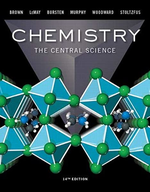?Consider the hypothetical reaction \(\mathrm{A}(g)+2 \mathrm{~B}(g)
Chapter 15, Problem 15.92(choose chapter or problem)
Consider the hypothetical reaction \(\mathrm{A}(g)+2 \mathrm{~B}(g) \rightleftharpoons\) 2 C(g), for which \(K_{c}=0.25\) at a certain temperature. A 1.00-L reaction vessel is loaded with 1.00 mol of compound C, which is allowed to reach equilibrium. Let the variable x represent the number of mol / L of compound A present at equilibrium.
(a) In terms of x, what are the equilibrium concentrations of compounds B and C?
(b) What limits must be placed on the value of x so that all concentrations are positive?
(c) By putting the equilibrium concentrations (in terms of x ) into the equilibriumconstant expression, derive an equation that can be solved for x.
(d) The equation from part (c) is a cubic equation (one that has the form \(a x^{3}+b x^{2}+c x+d=0\) ). In general, cubic equations cannot be solved in closed form. However, you can estimate the solution by plotting the cubic equation in the allowed range of x that you specified in part (b). The point at which the cubic equation crosses the x-axis is the solution.
(e) From the plot in part (d), estimate the equilibrium concentrations of A, B, and C. (Hint: You can check the accuracy of your answer by substituting these concentrations into the equilibrium expression.)
Text Transcription:
A(g)+2 B(g) \rightleftharpoons
Kc = 0.25
ax3 + bx2 + cx + d = 0
Unfortunately, we don't have that question answered yet. But you can get it answered in just 5 hours by Logging in or Becoming a subscriber.
Becoming a subscriber
Or look for another answer
